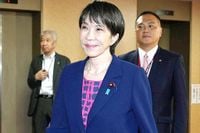Japan’s political landscape has been thrown into disarray following the collapse of a coalition that had underpinned the nation’s government for more than a quarter of a century. The recent election of Sanae Takaichi as head of the ruling Liberal Democratic Party (LDP) on October 4, 2025, which should have paved the way for her to become the country’s first female prime minister, has instead ignited a period of deep uncertainty and political maneuvering. The breakdown of the LDP’s alliance with the Buddhist-backed Komeito party just six days after her victory has left the LDP scrambling for new partners and raised the very real prospect that Japan could soon see its first non-LDP prime minister in nearly three decades.
According to DW, the 26-year partnership between the LDP and Komeito, long marked by underlying tensions, finally unraveled amid Komeito’s mounting discomfort with Takaichi’s hawkish security policies and ambiguous stance on the controversial Yasukuni Shrine. Takaichi, an arch-conservative and protégé of former Prime Minister Shinzo Abe, has previously visited the shrine, which is seen by many in China, South Korea, and even within Japan as a symbol of whitewashing wartime atrocities. When pressed after her confirmation as LDP leader, Takaichi refused to rule out further visits, insisting, “the shrine is not a diplomatic issue,” and that honoring the war dead “should be judged at the appropriate time.”
This response set off alarm bells at Komeito headquarters. Hiromi Murakami, a political science professor at Temple University’s Tokyo campus, told DW, “Komeito was already worried about Takaichi’s hawkish stance on security, on relations with South Korea and China, and their fear was that she would go even further as soon as she was in office.” The final straw, however, may have come when Takaichi appointed Koichi Hagiuda—an LDP ex-minister who resigned less than two years ago over a major financial scandal—to a senior party position. “Hagiuda’s return has really annoyed Komeito and it makes it appear that Takaichi simply does not care about an issue that enraged the electorate and was arguably the main reason they have fared so badly in recent elections,” Murakami added.
The immediate political fallout has been dramatic. The LDP now holds just 197 seats in the House of Representatives, well short of the 233 required for a majority, and 101 seats in the House of Councillors, also below the 125-seat threshold. Takaichi’s leadership thus begins with the LDP in a minority position, forced to seek new allies or face a united opposition determined to capitalize on the party’s weakness. Komeito, for its part, has pledged to support a unified candidate against Takaichi in the upcoming parliamentary confirmation, scheduled for October 20. If an opposition politician prevails, it would mark the first time since January 1996 that a non-LDP figure has assumed Japan’s top office.
But while Takaichi’s ascent is historic, it’s hardly a sign of LDP rejuvenation. As East Asia Forum notes, her victory is less a triumph of conservative-nationalist strength than a symptom of the party’s deep malaise. The recent LDP presidential race “showcased how the party’s failure to grapple with Japan’s strategic policy challenges and the obsolescence of its electoral dominance are two sides of the same coin.” The leadership contest saw Takaichi and her rivals acknowledge the LDP’s existential crisis, but none offered real solutions. Instead, the battle became one of short-term tactics, with Takaichi’s hardline positions on immigration and national identity giving her the edge over more moderate candidates like Agriculture Minister Shinjiro Koizumi and Chief Cabinet Secretary Yoshimasa Hayashi.
Yet, the numbers tell a different story. The LDP’s internal vote system favored Takaichi narrowly over Koizumi, despite reformist candidates collectively receiving slightly more support among rank-and-file party members. In the first round, conservative-nationalist votes consolidated behind Takaichi, while reformist support split. When no candidate secured a majority, the second round pitted Takaichi against Koizumi, but with a twist: only LDP Diet members voted anew, while rank-and-file votes from the first round were simply carried over. This meant that supporters of eliminated candidates lost their voice. In the end, Takaichi won 36 of 47 prefectures in the carried-over vote, but if preferential voting had been used, Koizumi would have come out ahead in 27 prefectures to Takaichi’s 20. As East Asia Forum points out, “her victory in the presidential race overinterprets the strength of Takaichi and the conservative nationalists within the LDP.”
The collapse of the LDP-Komeito coalition has exposed the party’s vulnerabilities at a critical moment. The LDP has been bleeding support in the wake of the Unification Church and political slush fund scandals, which contributed to its losses in the October 2024 and July 2025 elections. These setbacks relegated the LDP-Komeito coalition to minority status in both houses, making legislative progress all the more difficult. The party’s fear of losing further ground to the populist right—particularly the far-right Sanseito party—has pushed it into a defensive crouch, with many concluding that only a staunch conservative like Takaichi could stem the tide. But as Gerald Curtis, writing for East Asia Forum, warns, this strategy is a political dead end: “The party’s failure to offer a message that speaks to the broader electorate’s concerns won’t help the LDP win seats at the next lower house election.”
With the ruling coalition in tatters, opposition parties are now discussing forming a united front and putting forward a single candidate to challenge Takaichi for the premiership. Even the far-right parties that siphoned votes from the LDP in the last election are keeping their distance, hoping to gain more support or even replace the LDP entirely if it collapses. Toshimitsu Shigemura, a professor of politics at Waseda University, told DW, “Takaichi and the LDP are both in deep trouble.” He observed that had Koizumi won the leadership, he might have been able to keep Komeito in the coalition, but now “the party only elected her days ago and so they cannot realistically replace her, even though it seems clear they would have been far better off electing Shinjiro Koizumi.”
The political horse-trading is expected to continue up to the October 20 confirmation deadline. Takaichi’s team is reportedly reaching out to the centrist Constitutional Democratic Party of Japan (CDPJ) and the Japan Innovation Party, but both appear hesitant to join forces. Meanwhile, Komeito’s decision to back a single opposition candidate further complicates Takaichi’s path. The LDP, which has ruled Japan almost uninterrupted since 1955, now finds itself isolated, battered by scandal, and facing the real possibility of losing its grip on power.
As Japan’s party system begins to fracture, observers warn that the country faces a leadership vacuum at a time when strategic vision is urgently needed. “Right now, the LDP does not have a political philosophy,” Shigemura said. “It is simply trying to survive. And that is very worrying because the nation faces many serious issues that need to be addressed, at home and abroad.” With the international order that once secured Japan’s prosperity and security now in flux, the stakes for effective leadership could hardly be higher. The coming weeks will determine whether Takaichi can forge new alliances or if Japan is on the cusp of a political transformation not seen in a generation.


